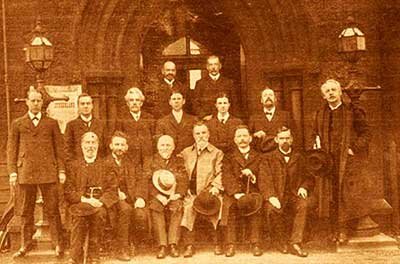European Pentecostal Beginnings

A group attending a Sunderland (U.K.) Convention in 1912, including the leading European Pentecostals of the time. (Front row, left to right) Smith Wigglesworth, T. Hackett, Gerrit Polman, Jonathan Paul, Thomas B. Barratt, Emil Humburg, Mr. Schilling, and A. A. Boddy; (centre) John Leech, a Mr. Techner, J. H. King, Stanley Frodsham and T. Moggs; (back row) Cecil Polhill and W. H. Sandwith.
The Pentecostal movement in Europe developed from the ministry of Thomas Ball Barratt, an Englishman by birth, but later naturalized as a Norwegian when his family moved to Norway. He was powerfully baptised in the Spirit in New York in Nov. 1906. His story is told on this site here. When he returned to Oslo (then Christiania) in December, Barratt held meetings in a large gymnasium and preached the Pentecostal message. Extensive publicity of these initial Pentecostal meetings, coupled with news from Azusa Street, resulted in many hungry-hearted European believers to travelling to Oslo to hear, including Alexander Boddy from England (Mar. 1907) and Jonathan Paul from Germany (Apr. 1907).
Many countries in Western Europe were impacted by the Pentecostal outbreak in Norway. In early 1907 Barratt visited and encouraged a work in Sweden, initiated by Andrew G. Johnson, a Swedish American baptized in the Spirit at Azusa Street. In Mar. 1907 Alexander Boddy visited and the subsequent mission of Barratt at Sunderland in Sept. 1907 caused the work in UK to explode. In the spring of 1907 two Norwegian visitors from Oslo ignited the work in Germany. In June 1907 Barratt spread the fire in Denmark. In the summer of 1907, the same Norwegian visitors visited Switzerland with a follow-up mission by Barratt (1908). In the fall of 1911 Finland was visited by Barratt, spreading the message across the continent.
It took a little longer for Pentecostal groups to be established elsewhere in Europe but before WWI arrived there were Pentecostals in Belgium, France, the Baltic states, and Russia. In Amsterdam, Holland, Gerrit and Wilhelmina Polman heard of Azusa Street by receiving the Apostolic Faith magazine. Wilhelmina was baptized in the Spirit in Holland in 1907, and later her husband received the baptism in England. In Italy the movements beginnings in 1908 came through Italian-American missionaries bringing the message from the Azusa Street to their homeland.
Until WWI Pentecostal evangelism, Pentecostal periodicals such as Boddy’s ‘Confidence’ magazine and annual conferences held Sunderland, England (together with Mulheim, Germany; Orebro, Sweden and elsewhere) spread the message and the experience. The cumulative effects produced a strong and contagious Pentecostalism throughout the continent. Press coverage, though often negative, often created more interest and attracted visitors.
More details can be found in this site under the Revival Heroes, 20th century section.



